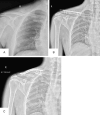Augmentation of clavicular fractures by dual plating
- PMID: 40688051
- PMCID: PMC12267127
- DOI: 10.62347/HWHH2373
Augmentation of clavicular fractures by dual plating
Abstract
Introduction: The clavicle displays significant motion across all three anatomical planes, which poses challenges for achieving rigid internal fixation. While adding a second plate can increase construct stability, concerns exist about the potential compromise of the periosteal blood supply. This study evaluated the union rate, complications, reoperation rates, and functional outcomes of using an extra periosteal dual-plate fixation as an alternative to the conventional single-plate fixation for acute clavicle fractures at 1-year follow-up.
Methods: In this prospective study (May 2023-May 2024), 25 patients with acute clavicle fractures underwent open reduction and internal fixation within four weeks of injury. Dual orthogonal plating was performed in all cases meeting inclusion criteria (midshaft or lateral-third fractures) and also in patients requiring revision after failure of a primary single plate. All procedures were extraperiosteal to preserve blood supply. Patients were followed for a minimum of one year. Outcome measures included radiographic union (regular interval X-rays) and functional recovery assessed by the Constant-Murley shoulder score. Complications and any reoperations were recorded. Institutional ethical approval was obtained and informed consent was taken from all patients.
Results: A total of 25 patients (7 females, 18 males; mean age 39.7 ± 10.0 years) were treated and followed for an average of 11.3 ± 4.1 months. Of these, 23 patients (92%) underwent dual plating primarily (20 midshaft [80%] and 3 lateral-end [12%] fractures), and 2 patients (8%) had dual plating as a revision after failed single plating. By final follow-up, all 25 fractures achieved full bony union with no cases of nonunion or implant failure. The average time to union was ≤3 months in 15 patients and >3 months in 10 patients; all delayed unions had healed by one year without additional intervention. Shoulder function improved steadily, with mean Constant-Murley scores of 76.2 ± 6.1 at 6 weeks, 83.5 ± 3.5 at 3 months, and 92.2 ± 3.0 at 6 months post-surgery. According to Constant score categories, 20 patients (80%) had "very good" shoulder function and 5 patients (20%) had "good" function at final follow-up. Complications were infrequent: 2 patients (8%) developed superficial wound infections (resolved with antibiotics), and 6 patients (24%) experienced implant prominence/irritation. No hardware breakage, loosening, or refracture occurred, and no patient required reoperation for hardware-related problems within the follow-up period.
Conclusion: Dual-plate augmentation of acute clavicle fractures proved to be a reliable fixation strategy in this series, yielding a 100% union rate and a low incidence of complications. The application of a second plate in complex or highly unstable clavicle fractures did not adversely affect fracture healing or increase complication rates. In cases of failed single-plate fixation, revision with dual plating facilitated successful union and good functional outcomes. The primary drawback observed with dual plating was implant prominence in some patients, suggesting a need for further refinements to minimize hardware profile.
Keywords: Clavicle fracture; biomechanics; constant-murley score; dual plate augmentation; nonunion.
IJBT Copyright © 2025.
Conflict of interest statement
None.
Figures





References
-
- Postacchini F, Gumina S, De Santis P, Albo F. Epidemiology of clavicle fractures. J Shoulder Elbow Surg. 2002;11:452–6. - PubMed
-
- Rehn CH, Anglen J. Operative versus nonoperative care of displaced midshaft clavicle fractures: a systematic review. J Orthop Trauma. 2021;35:220–6.
-
- Irsay L, Nistor AR, Ciubean A, Borda IM, Ungur R, Onac I. The importance of the clavicle biomechanics in the shoulder movement. Health Sports Rehabil Med. 2020;21:93–6.
LinkOut - more resources
Full Text Sources
